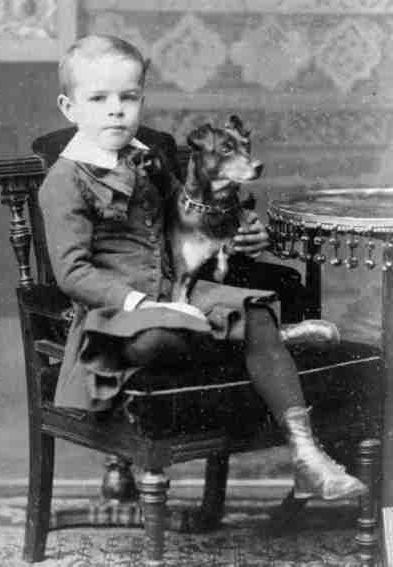
Eton Collar Neckwear: Age Conventions

Figure 1.--This boy in a photograph probably taken in the 1890s wears a relatively small bow with his Eton collar and kilt suit. Note that it is tied under the collar. Most boys this age in the late 19th century would wear their Etion collars with floppy bows--especially before breeching.
|
Yonger boys were the most likely to wear their Eton collars with floppy bows. This was especially true of the very young boys still wearing kilt suits or other juvenile outfits. Even older boys might wear a floppy bow with their first mature suit like a Norfolk suit. There does not appaear to have been a lot of strict conventions in this regard. It was largely left to the discression of the mother. Floppy bows were popular with mothers who like to make small distinctions in clothing as their sons grew up. Thus a boy might wear a new suit and Eton collar for a year or two with a large floppy bow, perhaps the same bow he wore with his Fauntleroy suit. When he was a liitle older might be allowed to wear his new Norfolk suit and Eton collar with a smaller bow or even without one. This appealed to a thrify mother who could change boy's look with no additional cost. HBC has not yet determined if any age conventions were involved in the other neckwear fashions such as no tie or the different kind of ties.
Neckwear Types
There appear to have been clear age destinctions associated with boys' neckwear.
Floppy bows
Yonger boys in the late 19th century were the most likely to wear their Eton collars with floppy bows. This was especially true of the very young boys still wearing kilt suits or other juvenile outfits. Even older boys might wear a floppy bow with their first mature suit like a Norfolk suit. There does not appaear to have been a lot of strict conventions in this regard. It was largely left to the discression of the mother. While floppy bows were commonly worn with Eton collars, they were in nearly all instances relatively modestly sized floppy bows. One never sees the huge floppy bows often worn with ruffleled Fauntleroy collars worn with Eton collars.
Ties
HBC has not yet determined if any age conventions were involved in the other neckwear fashions such as no tie or the different kind of ties. Older boys by the early 20th century were commonly wearing neckties with Eton collars. HBC has, however, noted some older boys without neckties, so this subject requires additional work.
No neckwear
HBC is not positive just what the age convention was for neckwear with Eton collars. It appears to have changed over time. Yonger boys in the 1880s almost always wore bows with their Eton collars. HBC notes, however, that younger boys wearing Eton suits and collars by the 1930s and 40s generally did not wear neckwear. This convention followed when Americasn boys began to wear Peter Pan collars with their American styled Eton suits in the 1950s, they often did not wear ties--although some did wear bow ties. These are just initial assessments and this topic needs to be pursued in more detail.

Figure 2.--This American boy judging from the tricycle was probably photographed in the early 1890s. Notice that he wears a small floppy bow. He looks to be about 6 or 7 years old. It is likely that he wore a Fauntleroy suit when younger, probably with a larger floppy bow.
|
Conventions
Floppy bows were especially popular with mothers who like to make small distinctions in clothing as their sons grew up. Thus a boy might wear a new suit and Eton collar for a year or two with a large floppy bow, perhaps the same bow he wore with his Fauntleroy suit. This was only possible, however, for mothers that chose relativeky small floppy bows for their sons' Fauntleroy suit. When the boy was a liitle older might be allowed to wear his new Norfolk suit and Eton collar with a smaller bow or even without any bow at all. Mother could tus make at least some modification each year tonrecognize the increasing maturityb of her growing son. Interestingly, some family portraits so brothers wearing outfits with these age specific modifications. Some mothers, on the other hand, liked to dress her sons, or even all the children, in identical or even coordinayed outfits.
Fashion
This appealed to a thrify mother who could change boy's look with no additional cost. This mostly occurred with younger boys as mother's could select their clothing with little resistance. Thus she could choose the colors and patterns that appealed to her. Women are of course much more fashion concious than men and like to change their outfits frequently. As boys got older, however, they would begin to voive their own opinions which made it more difficult for mothers to let their fashion tastes frequently change their son's bows.
Christopher Wagner

Navigate the Historic Boys' Clothing Web Site:
[Return to the Main Eton collar neckwear page]
[Return to the Main Eton collar page]
[Return to the Main Eton suit page]
[Introduction]
[Activities]
[Biographies]
[Bibliographies]
[Chronologies]
[Contributions]
[Countries]
[FAQs]
[Photography]
[Style Index]
[Boys' Clothing Home]
Navigate the Historic Boys' Clothing Web chronological pages:
[The 1840s]
[The 1850s]
[The 1860s]
[The 1870s]
[The 1880s]
[The 1890s]
[The 1900s]
[The 1910s]
[The 1920s]
[The 1930s]
[The 1940s]
Navigate the Historic Boys' Clothing Web style pages:
[Long pants]
[Knickers]
[Short pants]
[Scottish kilts]
[School uniform]
[Sailor suits]
[Eton style]
[Ring bearer/page costumes]
[First communion]
Created: August 12, 2000
Last updated: August 12, 2000




